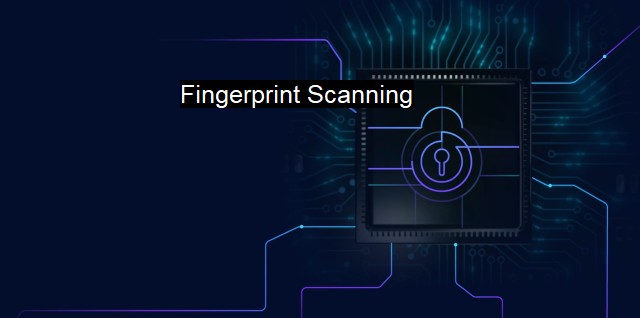What is Fingerprint Scanning?
The Role of Fingerprint Scanning in Strengthening Cybersecurity Measures and Antivirus Protection against Hacking Threats
Fingerprint scanning, also known as biometric identification, is a well-established cybersecurity method that confirms or verifies a person's identity based on the unique traits of their fingerprints. It is broadly applied as an important technique for protection and identity authentication in computing, mobile applications, and other tech channels that revolve around data security. This method is lauded within the cybersecurity field due to its potent capability to ward off unauthorized access attempts, thereby reducing chances of critical data breaches.Fingerprints have been consistently used to determine identities for many years due to their unique nature. The complex patterns of ridges and valleys on a person’s finger are established during early development and remain permanent throughout a person’s life, retaining their exclusivity even amongst identical twins. This unique feature embedded in fingerprints has become a fundamental part of building robust access control systems.
When fingerprint scanning is used in the context of antivirus and cybersecurity, the details of fingerprint traits are stored as digital information referenced in biometric data systems. Devices encrypted for fingerprint scanning capture the minutiae of the user's physical fingerprint, converting the data into patterns that can be read digitally, commonly represented as binary or hexadecimal data. This vital information becomes part of the software encryption methodology that establishes a safeguard against unauthorized access, ensuring only the authenticated user or users can handle their devices and access their data.
When someone attempts to access a device using fingerprint scanning, the system compares the new scan to the previously stored data. If the traits align precisely, access is authenticated and granted. if the scans do not match, the system denies access, thereby serving as a formidable barricade against intruders or cyber threats.
Fingerprint scanning upholds the ideology of multifactor authentication, immensely reducing the risk of identity theft and unauthorized access, often complementing other security systems like password protection. It provides an extended layer of security compared to standard authentication methods like the typical username-password combination, paving the way for full-proof access control. By using your biological imprint as your access key, you reduce the risk of forgetting your password or falling prey to cyber hacking attempts to crack your password.
Despite its numerous advantages, the mechanism of fingerprint scanning is not infallible. Since it deals with highly sensitive personal data, severe breaches can lead to irrevocable damage. Once stolen, biometric data like fingerprints cannot be reset or changed like passwords, posing more prominent privacy concerns if biometric data falls into the wrong hands. Therefore, it is consequential to tightly secure the repositories that store fingerprint details.
In the wake of advancing technology, newer techniques like liveness detection and anti-spoofing measures have been developed to counter potential bypasses of the access systems via fake replicas. Thoughtful implementation of these technologies can significantly add to the resilience of the cybersecurity strategy at hand.
Biometric technologies such as fingerprint scanning have spurred advancements within the antivirus cybersecurity realm. As these features proliferate mobile phones, laptops, and other digital devices, antivirus software is equipped to protect biometric information, making defense systems more layered and comprehensive.
Fingerprint scanning has transformed cybersecurity in multifaceted ways. Its application in numerous devices testifies to its effectiveness as a reliable tool in enforcing robust access control and offering an initial line of defense in antivirus software. While it does present some challenges primarily surrounding its inviolability, solutions continue to emerge, continually enhancing the strength and resilience that fingerprint scanning brings to the cybersecurity space.

Fingerprint Scanning FAQs
What is fingerprint scanning in cybersecurity?
Fingerprint scanning is a biometric technology used to authenticate or identify individuals based on their unique physical characteristics. In cybersecurity, fingerprint scanning involves capturing an individual's fingerprints and comparing them to a database of authorized users to grant or deny access to a system or device.How do antivirus programs use fingerprint scanning?
Antivirus programs use fingerprint scanning to identify malware by analyzing its unique characteristics. The antivirus software creates a digital "fingerprint" of known malware and compares it to the files on the system. If the software detects a match, it will either quarantine or delete the file to prevent harm to the system.What are the benefits of fingerprint scanning for cybersecurity?
Fingerprint scanning provides an additional layer of security to traditional authentication methods. Since fingerprints are unique to each individual, it is difficult for hackers to replicate them. Fingerprint scanning also eliminates the need for passwords or PINs, which can be easily lost, stolen or hacked.Is there any risk associated with fingerprint scanning in cybersecurity?
Although fingerprint scanning is a secure authentication method, it is not immune to hacking attempts. Hackers can potentially bypass fingerprint scanners by creating fake fingerprints or using other methods. Also, storing biometric data can pose a risk if the organization responsible for the data fails to protect it appropriately.| | A | | | B | | | C | | | D | | | E | | | F | | | G | | | H | | | I | | | J | | | K | | | L | | | M | |
| | N | | | O | | | P | | | Q | | | R | | | S | | | T | | | U | | | V | | | W | | | X | | | Y | | | Z | |
| | 1 | | | 2 | | | 3 | | | 4 | | | 7 | | | 8 | | |||||||